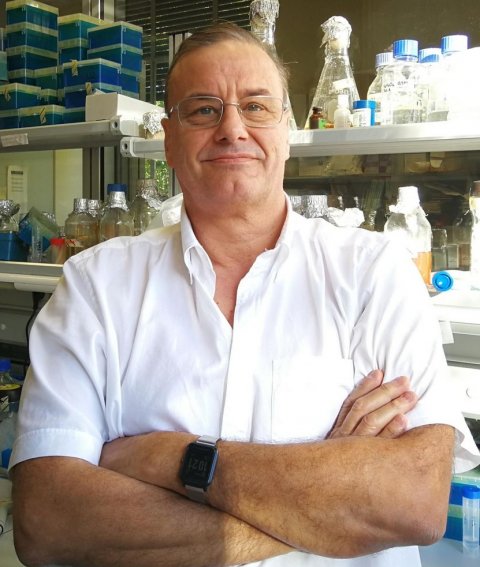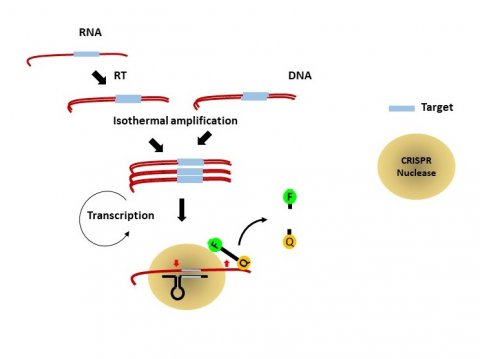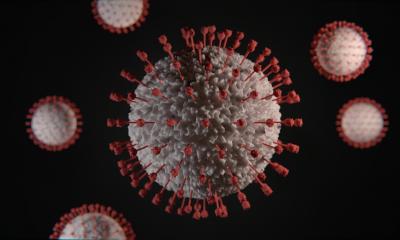Article • Detecting coronavirus infections
Covid-19: CRISPR-based test gives GPs quick results
Recent research in Clustered Regularly Interspaced Short Palindromic Repeats (CRISPR) has identified two enzymes that can detect Covid-19 RNA as simply as a pregnancy test Jesús Pla, an eminent microbiologist at the Complutense University in Madrid, explained in our exclusive interview.
Report: Mélisande Rouger

CRISPR technology could help alleviate workloads in packed hospitals and expand testing to primary care and lower income settings. The system provides a simple, rapid and reliable way to detect Covid-19, according to Jesús Pla.
Cas12 and Cas13 enzymes have been shown, upon recognition of the region of interest, to prompt what is called a collateral effect that acts on any DNA or RNA molecule present. ‘Once you introduce a substrate in your solution and obtain fluorescence, you can cut not only what the enzymes recognise, but also every piece of DNA or RNA in the solution,’ Pla explained. ‘The triggered collateral activity, which degrades every piece of DNA or RNA around, can reveal the presence of Covid-19 RNA.’
Recommended article

News • For the development of CRISPR/Cas9
Nobel Prize in Chemistry goes to Emmanuelle Charpentier and Jennifer A. Doudna
The Royal Swedish Academy of Sciences has decided to award the Nobel Prize in Chemistry 2020 to Emmanuelle Charpentier from the Max Planck Unit for the Science of Pathogens, Berlin, Germany, and Jennifer A. Doudna from the University of California, Berkeley, USA, “for the development of a method for genome editing”, more commonly known as the 'gene scissors' CRISPR/Cas9.
Significant benefits
Labs don’t even need a fluorometer to detect the virus’s RNA in the solution; they can use a simple colour strip instead. ‘It’s not sophisticated, you won’t get the precision and sensitivity you’d obtain with a fluoro-meter, but you will detect the virus’s RNA. It’s a visual test.’

Results can be obtained much faster with CRISPR-based tests than with PCR tests. ‘PCR takes three to four hours, but you need to collect many samples, send them to a specialised lab, pass through a filer, run together, so in the end you have to wait one or two days minimum to get the result,’ Pla said. ‘With CRISPR-based tests, you get the results in an hour and a half.’ This speed of execution could help alleviate workflow in strained hospitals, especially in cities like Madrid, where incidence recently broke the 700 per 100,000 infected cases, far above the WHO threshold.
The test’s simplicity and low cost make it available to any lab around the world. ‘It’s very simple to do and detailed protocols have already been published,’ Pla said. ‘You need minimum experience in purifying enzymes, so any mid experience lab with a minimal knowledge of biochemistry can do the test. And that’s the most expensive, the rest are just buffers, regions, substrates for detection, etc.’
Unlike PCR, CRISPR enables DNA amplification without having to use costly, sizeable equipment, such as a thermo cycler that ups and downs the temperature. ‘With CRISPR,’ he said, ‘you can work at constant temperature, so anywhere works. You don’t even need electricity, which could be a plus in developing countries. You could use it in any point of care.’
Two systems have been developed that showed sensitivity and sensibility in the 97-98% range and will be commercialised soon, Pla believes.
More tools to support PCR
Further tests are being developed that can help complement PCR, for example antigen detection, which helps detect the virus by identifying its protein. The more tests being performed, the better. ‘If you could do a test every week in every population, Covid-19 would disappear. The problem is that you can’t do PCR to 45 million people (Spain’s population) every week,’ he pointed out. ‘You need to rely on quick methods and POC in order not to overload hospitals.’
CRISPR and antigen detection are not yet as powerful as PCR, but they are low cost, specific, reliable, simple, rapid and almost as sensitive. They can be performed in any point of care anywhere around the world. ‘People with basic training and preparation could make an early diagnosis and take immediate decisions. ‘The good point with CRISPR or antigen testing is that you can do it in primary care, directly at the GPs. You can get the results within an hour. The more tests we do, the more we control the disease,’ Pla concluded.
Profile:
Dr Jesús Pla MD PhD, teaches microbiology in the Department of Microbiology and Parasitology, Faculty of Pharmacy at Complutense University in Madrid. He coordinated the PhD Program in Microbiology and Parasitology between 2014 and 2019, and served as editor of microbiology journals and as evaluator of local, national and international projects, and for several scientific journals. Pla’s recent work has focused on different aspects of the biology of the pathogenic fungus Candida albicans, especially the development of genetic tools in this fungus.
16.11.2020











